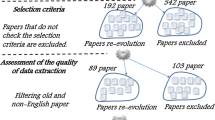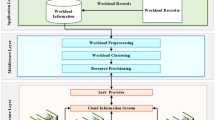Abstract
Self-adaptation is the mechanism that is used automatically by some clustered web servers for resolving issues such as server bottleneck and overload. Such mechanisms are usually reactive meaning that they will be used when some issue occurs. However, taking an adaptation mechanism after arising a bottleneck or overload may be late and can cause some problems. Such problems could be resolved if we are able to predict future behavior of servers. To this end, based on our previous experiences, we presented a framework by which an adaptation strategy is selected based on a learning-based predictive method. Through the prediction, we are provided with a number of decision-making parameters for adaptation strategy selection. To show the effectiveness of our framework, we applied it for design and implementation of a differentiated cluster-based web server system and showed results. In such systems, each cluster is considered to serve a specific service. By comparison of simulation results between our predictive method and the reactive one, we found: (1) increase of the number of replied requests by servers, (2) decrease of average response time, and (3) increase of resource utilization of the system twofold to threefold.











Similar content being viewed by others
References
Anaya IDP et al (2014) A prediction-driven adaptation approach for self-adaptive sensor networks. In: The 9th ACM international symposium on software engineering for adaptive and self-managing systems, pp 145–154
Babamir SM, Hassanzade E, Azimpour M (2015) Predicting potential deadlocks in multithreaded programs, concurrency & computation, practice & experience, Wiley, 27(17):5261–5287
Cámara J et al (2013) Evolving an adaptive industrial software system to use architecture-based self-adaptation. In: The 8th international symposium on software engineering for adaptive and self-managing systems
Cámara J et al (2014) Empirical resilience evaluation of an architecture-based self-adaptive software system. In: The 10th international ACM sigsoft conference on the quality of software architectures. ACM SIGSOFT QoSA Distinguished Paper Award, France, Lille
Cámara J et al (2014) Impact models for architecture-based self-adaptive systems. In: The 11th international symposium on formal aspects of component software (FACS2014), Bertinoro, Italy
Garlan D (2013) A 10-year perspective on software engineering self-adaptive systems (keynote). In: The 8th international symposium on software engineering for adaptive and self-managing systems. IEEE Press, pp 2–2
Garlan D, Schmerl B (2006) Architecture-driven modelling and analysis. In: The 11th Australian workshop on safety related programmable systems, 69:3–17
Sheikhi S, Babamir SM (2012) A novel model-based slicing approach for adaptive softwares. In: The 3rd international conference on contemporary issues in computer and information sciences, pp 195–199
Lember J, Koloydenko AA (2014) Bridging Viterbi and posterior decoding: a generalized risk approach to hidden path inference based on hidden markov models. J Mach Learn Res 15:1–58
Cheng SW, Garlan D, Schmerl B (2006) Architecture-based self-adaptation in the presence of multiple objectives. In: The international workshop on self-adaptation and self-managing systems, Shanghai, China, pp 2–8
Garalan D (2009) Rainbow: engineering support for self-healing systems: invited talk. In: The XXIII Brazilian symposium on software engineering
Poladian V et al (2007) Leveraging resource prediction for anticipatory dynamic configuration. In: The 1st international conference on self-adaptive and self-organizing Systems, pp 214–223
Cheng SW, Poladian VV, Garlan D, Schmerl B (2009) Improving architecture-based self-adaptation through resource prediction. In: Betty HC et al (eds) Software engineering for self-adaptive systems. Springer, Berlin, pp 71–88
Herbst NR, Huber N, Kounev S, Amrehn E (2013) Self-adaptive workload classification and forecasting for proactive resource provisioning. In: The ACM/SPEC international conference on performance engineering (ICPE), pp 187–198
Sharifiana S, Motamedia SA, Akbarib MK (2011) A predictive and probabilistic load-balancing algorithm for cluster-based web servers. Appl Soft Comput 11(1):970–981
Angelopoulos1 K, Souza VES, Pimentel J (2013) Requirements and architectural approaches to adaptive software systems: a comparative study. In: The 8th ICSE workshop on software engineering for adaptive and self-managing systems, pp 23–32
Tallabaci G, Souza VES (2013) Engineering adaptation with Zanshin: an experience report. In: The 8th international symposium on software engineering for adaptive and self-managing systems, IEEE Press, pp 93–102
Cheng SW, Garlan D (2012) Stitch: a language for architecture-based self-adaptation. J Syst and Softw, Special Issue on State of the Art in Self-Adaptive Systems. vol 85, no (12), Elsevier, pp 2860–2875
Jachan M (2012) Time-frequency-autoregressive-moving-average modeling, AV Akademikerverlag, publication
Franke J (2012) Markov switching time series models. In: Rao TS et al (eds) Chapter 5 of handbook of statistics, time series analysis: methods and applications. Elsevier, New York
Cappé O, Moulines E, Ryden T (2005) Inference in hidden markov models, Springer series in statistics
Rezaei V, Pezeshk H, Pérez-Sa’nchez H (2013) Generalized Baum–Welch algorithm based on the similarity between sequences. PLoS One 8(12):e80565. doi:10.1371/journal.pone.0080565
Jha GK, Sinha K (2014) Load balancing technique to improve QoS for lightpath establishment in optical WDM networks. J Theor Appl Inf Technol 68(2):255–264
Marques C, Ilarri S, Barroso GC (2009) DARC: A dynamic architecture for reconfiguration of web servers clusters using multiagent systems. In: The 5th international conference on networking and services, pp 169–174
Serra DGA, Barroso G, Ramos R, Boudy J (2005) Assuring QoS diferentiationand load balancing on web servers clusters. In: The international conference on control aplications, pp 885–890
Olejnik R, Bouchi A, Toursel B (2002) An object observation for a java adaptative distributed application platform. In: International conference on parallel computing in electrical engineering, pp 171–176
http://www.cs.cmu.edu/~./acme/AcmeStudio/index.html. Accessed 4 Feb 2009
Author information
Authors and Affiliations
Corresponding author
Appendices
Appendix 1
Architectural desription of element types of web server cluster in ACME language

Appendix 2
High-level specification of an instantiation of a part of actual elements of web server cluster

Appendix 3
Adaptation strategies in the Stitch high-level language

Rights and permissions
About this article
Cite this article
Sheikhi, S., Babamir, S.M. A predictive framework for load balancing clustered web servers. J Supercomput 72, 588–611 (2016). https://doi.org/10.1007/s11227-015-1584-8
Published:
Issue Date:
DOI: https://doi.org/10.1007/s11227-015-1584-8




